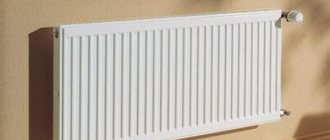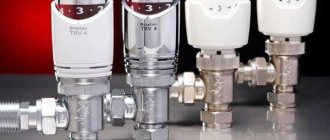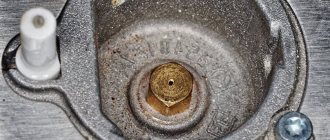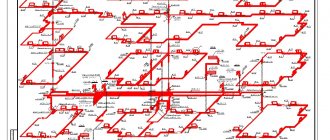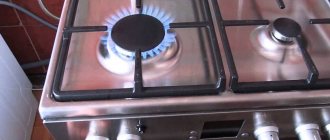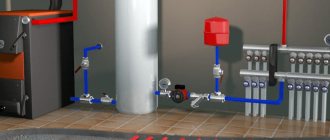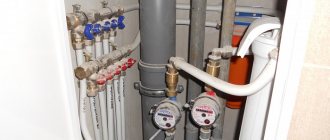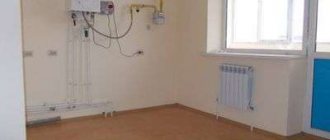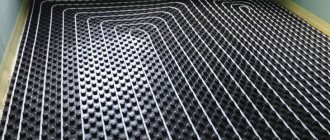Good afternoon, dear readers! Today I will continue the topic of central heating batteries. We will talk to you about the operation of heating batteries. Almost everyone needs this topic, and my task is to help you understand this issue once and for all. So, I hope you have already read my article: Correct installation of a central heating battery in an apartment. We will assume that the battery has been installed for you. What's next?
How long is the service life according to GOST?
The scope of production and operation of batteries is regulated by GOST 31311-2005 and SP 60.13330.2012. They indicate the service life of heating devices, depending on the materials from which they are made:
- cast iron lasts 25-35 years;
- bimetallic – 25-30 years;
- aluminum – 20-25 years;
- steel - 15-20 years.
By finding out which radiators heat your apartment and when they were installed, you can understand whether it is time to replace them.
If the batteries cope with heating the room, maintaining the temperature in the apartment from +18 ° C, do not leak and do not have other defects, the management company may refuse to replace them even if their service life has expired.
Representatives of the management company can assess the condition of the heating batteries. As a result of the inspection, the commission will draw up an act in which the necessary recommendations will be given. If it is recommended to replace radiators that are common property, you can write an application for these manipulations to be carried out by the management company itself.
Attaching the radiator to the floor - how to install it correctly
Apartment wall structures are not always able to reliably withstand the battery load for a long time. If the heating device has a large mass, or the walls have a lightweight structure, then additional floor fixation is necessary. It is carried out using legs, which are sometimes included with the device, or special brackets that are attached to the floor using nails or dowels.
Floor mounting is recommended even for relatively lightweight aluminum and bimetallic radiators; As for heavier cast iron, steel or copper batteries, it is mandatory for them.
Accident during and outside the heating season
The housing company is entirely responsible for internal communications unless the residents have made the repairs themselves. Therefore, if a pipe bursts during the heating season, then all responsibility falls on their shoulders.
Outside the heating season, an accident can also occur, despite the fact that the coolant does not circulate at this time. At the end of the heating season, heat supply companies begin to conduct hydraulic tests.
This is necessary to identify problem areas and eliminate them before the start of the next heating season.
To exclude such actions:
- residents are temporarily disconnected from supply lines;
- The service installs valves in each apartment.
Do not rush to immediately look for those responsible for what happened - we recommend recording the breakthrough so that you can later use photos or videos when analyzing the case in court.
Coolant supply direction
The connection of a bimetallic heating radiator can be made from below - in this case, a lower vertical collector is used. When using such a scheme, the main thing is to know exactly which of the inputs the water is connected to. These data can be clarified in the technical data sheet.
Lateral and diagonal eyeliner is also possible. In the last two options for connecting bimetallic heating radiators, the coolant supply is introduced from above, while a return pipe is installed from below.
Self-installation of heating equipment
In apartment buildings, such events are carried out by specialized employees who begin to act after writing the appropriate application. Replacing batteries in a private home is not difficult. The main thing in this matter is to follow the entire sequence of actions.
Replacing a heating radiator with your own hands includes several points:
Draining waste fluid. To do this, you need to open the valve on the central fuel system. Next, connect the hose to drain the liquid from the pipes.
Dismantling the old heating system. If the old radiators are fixed with special nuts, then they are carefully unscrewed and the batteries are removed.
Marking the wall for future fastenings. In the future, this will allow the heating installation to be evenly distributed on the wall surface. To do this, use a building level, which will help adjust the correct angle of inclination.
Installation of special brackets. They help secure the product tightly in the desired position. Fixing the radiator installation.
Connecting the system. For this purpose, several ways of fixing the heating device have been developed. The most effective are considered to be: side, bottom saddle, diagonal. A photo of replacing a heating radiator makes the task much easier.
The lateral method is used for heating apartment buildings with vertical fuel distribution. To do this, you will need radiators with ten compartments.
The lower saddle is suitable for horizontal wiring of the heating system. The radiator size can reach 1.5 m. The number of sections ranges from 15 to 20.
The diagonal connection helps to evenly distribute the heat supply throughout the entire perimeter of the living space.
Functionality check
Upon completion of installation work, the functionality of the system is checked. Having opened the Mayevsky tap, they begin to fill the radiator through the return line. To do this, open the ball valve on the lower manifold. When all the air is out of the battery, water flows out of Mayevsky’s tap, it is turned off. Open the second ball valve on the upper manifold.
In order for the battery to warm up, all the air must be vented while filling it with coolant.
If there is no air left in the sections, the circulating coolant will begin to warm them up. The presence of cold spots indicates air pockets. The bleeding procedure through the Mayevsky tap is repeated until a positive result is achieved.
Laying heating pipes
Once the old heating system is removed, it's time to think about a new one. One of the questions in the instructions on how to change the battery in an apartment is the method of laying new pipes. First of all, one of two options is selected:
- Open
- Hidden
From an aesthetic point of view, hidden gasket is much better. Communications will be hidden from human eyes. However, this method has a number of disadvantages:
- Further maintenance of the system is difficult
- The cost of the work being carried out increases, and additional costs for building materials will appear in the estimate.
- A certain percentage of the heat will go to heating the decorative structure
The advantages of open heating systems, due to which they are preferred, are obvious to everyone:
- Lower cost of installation work, since materials are consumed in minimal quantities
- The pipes are in direct contact with the environment, thereby eliminating heat loss
- Simple further maintenance of communications
- Small time costs for laying pipes
Hidden pipe laying
As noted, hidden pipe laying is labor-intensive and time-consuming work. First, prepare:
- For natural circulation of the coolant, the pipe is placed directly into the suspended ceiling, and the outlet risers are run along a protective decorative box
- For forced circulation, a good solution would be to lay pipes in the walls or floor
- Markings are applied to the working surfaces and grooves are made with a hammer drill or grinder
The pipe is secured directly in the grooves with clips. In this case, near future radiators, the line should end with removable threaded adapters.
It is necessary to start decorating the surfaces only after all the batteries are in place and crimping has been carried out.
Open pipe laying
Laying pipes using the open method is more popular. At the first stage, you need to install radiators, an expansion tank, a boiler and other heating equipment.
In order for the pipes to look aesthetically pleasing, their exact location should be calculated. Diagrams sketched on paper taking into account the location of the furniture will not be superfluous.
Open laying can be organized in one of the following ways:
- The upper discharge pipe of large internal cross-section is laid between the radiator plugs under the window sill, while the pipe running along the bottom is led along the floor
- Both pipes are routed along the floor, but this method is only suitable for forced circulation
- For natural coolant circulation, the lower pipe is placed directly near the floor, and the upper pipe is placed as high as possible
Having decided on the method of laying the pipe line, you need to mark the walls and install retaining clips. The frequency of their location is 1-2 m. It is necessary to take into account that it is recommended to make the areas between the radiators solid. In non-standard areas, two clips are placed at the junction points - on one side and on the other.
Particular attention is paid to branches and turns. Before trimming, you will have to take careful measurements, have a design and engineering vision
We also advise you to find out more about individual heating in the apartment
Installation of new batteries
Before installing heating radiators in the apartment, you need to calculate everything again and accurately measure their location. In this case, you should not violate the rules prescribed in specialized documents (SNiP):
- Approximate distance between the floor and the bottom edge is 15 cm
- The approximate distance between the window sill and the top edge is 15 cm
- The gap between the radiator and the wall is at least 2 cm
First you need to secure the brackets on which the new radiators will be hung. Then nuts are put on them. All connections must be well sealed to prevent water leakage. It is also recommended to apply tow. There will be taps at each entrance.
The final working stage will be to check the entire heating system for operability. To do this, one end should be plugged, and on the other side, create a pressure with a pump or compressor that exceeds the working one by 1-2 atmospheres. If after some time the readings of the measuring pressure gauge do not change, you can screw in all connections and connect to the central system.
Additional video
Let's sum it up
There is definitely something difficult and impossible to do in how to change the battery in an apartment. However, you can’t count on easy work either. After completing the work, it is recommended to call a technician and let him verify that the system is assembled correctly.
What do you need to think about in advance?
If the decision to carry out this type of repair is made, you should find answers to a number of questions:
- When exactly and by whom will the work be carried out?
- What type of radiators should I use?
- Is it necessary to replace the pipes leading from the battery to the riser?
- How many sections will be needed for each room?
It is best to carry out such alterations in the summer, because before starting work you must obtain permission from the local housing office. In winter, officials are extremely reluctant to give such permissions, because they will have to shut off the common riser and leave other apartments without heating for some time.
But even outside the heating season, obtaining permission can be difficult. Those who have already solved similar problems talk about the need to wait several days, try to get an appointment with the right employees, etc. Some faced pressure: they were recommended to hire plumbers from the housing office to carry out all the work.
There are no restrictions in this matter. The main thing is that the replacement of heating batteries is carried out by an experienced plumber with appropriate qualifications. It is possible to identify all the flaws caused by inept installation only during operation.
Old radiators become dirty over time, inside and out; cleaning does not always help solve the problem of insufficient heating; replacement is a more effective option.
It is best to go to the housing office in the summer, and not in the fall, when queues peak. At this point, all the necessary materials need to be purchased, pre-assembled radiators, prepared tools, agreed with the team, if necessary.
If the house is connected to a central heating system, you should contact the maintenance service to coordinate the alteration. Here they can perform the necessary calculations to accurately determine the number of radiator sections, as well as clarify other technical issues.
You can calculate the required number of heating radiators yourself. We described in detail how to do this in this article.
Shut-off valves, which are installed on the “supply” and “return”, are necessary so that you can turn off the water at any time and remove the battery for repair or replacement
Lack of correct calculations can lead to imbalance of the home heating system.
For calculations, you will first need the information that is in the DEZ:
- type of boiler room (it can be central or individual for a particular house);
- type of system: two- or one-pipe;
- parameters of existing supply pipes;
- coolant characteristics: temperature, pressure, pH, etc.
Most often, old batteries are replaced with new modern models, usually aluminum or bimetallic. Although cast iron, copper and steel products are also available for sale. The type of radiator is needed when performing calculations.
When choosing a suitable radiator for a house or apartment, you need to focus on its main characteristics, which are detailed in the technical data sheet of the product
You will need such indicators as the pressure that the device can withstand, the maximum temperature of the coolant, heat transfer and other data. They can usually be found in the technical data sheet.
If not only the radiators are to be replaced, but also the pipes leading to them, you should choose a suitable material. This is usually steel, metal-plastic or polypropylene. Some craftsmen strongly recommend using only steel communications for centralized systems.
Depending on the type of pipes chosen, you will need appropriate equipment for welding them. MP and PP pipes are easier to install than steel. To work with metal, you need not only a welding machine, but also a device for cutting threads. Therefore, if the old pipes are clean enough, it is recommended to leave them and replace only the battery.
Old cast iron radiators retain heat well, but release it slowly; in addition, they are heavy, which complicates installation, which is why bimetallic and aluminum models are more popular
The weak point of metal-plastic structures is the connections. They must be performed very carefully; installation errors often lead to leaks. The popularity of MP pipes is explained by their relatively low price. Plastic is more expensive, but more reliable; if the welding is done correctly, the tightness of the joints will be very high.
You need to select suitable fasteners for the selected radiator. In this case, you need to take into account both the type of radiator and the material of the wall on which the installation will be carried out: brick, concrete, etc. Batteries are usually equipped with brackets of a suitable type.
To install one radiator, two brackets are usually used at the top and one at the bottom. Their position is carefully checked with a level to eliminate the possibility of misalignment during battery installation. However, some models are installed with a slight slope to ensure the removal of air trapped in the system. If the number of sections is more than twelve, another top bracket may be needed.
Replacing heating radiators
A radiator is a heating device with channels through which coolant passes. There are many reasons for replacing a radiator: they have rotted from old age and are leaking water in small streams. Such problems can arise from mechanical impact (impact). They do not provide the expected warmth and cannot withstand pressure - the fault is due to mineral deposits on the inner walls of the radiators themselves. This can lead to reduced clearance in the radiator.
Heating radiators in apartments are replaced more often than in private homes. In private homes, the owner can independently regulate the supply. This cannot be done in apartments, so you have to put up with what you have or install a convector. There are also thermostats for sale that can be installed in apartments and regulate the heat yourself.
When unscheduled replacement of radiators occurs, the cost of dismantling and installation increases. The best time to replace radiators is the off-season. The system, as a rule, is in a passive state, and permission to replace it will be much easier to obtain.
Types of radiators:
- Panel. Such radiators heat up faster than other types of batteries. Bottom or side connection. The battery is made of rolled steel.
- Columnar. Batteries of two collectors connected to each other by tubular columns. The materials for the manufacture of such radiators are aluminum and steel.
- Sectional batteries. Consist of two or more hollow sections. You can make an unlimited number of sections on a radiator; their number depends on the area of the room. You also need to take into account the weight of the entire structure so that the fastenings can withstand the entire load. Batteries can be made of cast iron, steel, aluminum and bimetal.
It doesn’t matter whether you replace heating radiators yourself or hire workers, you should always choose the best equipment
What is important to pay attention to?
The equipment passport indicates the test and operating pressure
You should pay attention to the operating data; in cases of force majeure, there will be a reserve of test pressure
Why is pressure so important? When heat is supplied to the 9th floor, the pressure is 6 atmospheres, and when supplied to the 23rd floor - 15 atmospheres. Not all types of radiators can withstand such pressure; those made of aluminum are eliminated immediately
In the private sector, it would be wise to install aluminum batteries, since high pressure is not required to supply coolant. In nine-story buildings, cast iron batteries are mainly used. They can easily withstand a working pressure of 9 atmospheres. If the pressure supply is higher, then in this case you need to install radiators made of high quality steel or bimetal
Not all types of radiators can withstand such pressure; those made of aluminum are eliminated immediately. In the private sector, it would be wise to install aluminum batteries, since high pressure is not required to supply coolant. In nine-story buildings, cast iron batteries are mainly used. They can easily withstand a working pressure of 9 atmospheres. If the pressure supply is higher, then in this case you need to install radiators made of high quality steel or bimetal.
Corrosion resistance is a very important factor when choosing equipment. Batteries that are almost resistant to corrosion include cast iron. Aluminum batteries are considered the weakest according to this criterion. If the choice is made of aluminum radiators, then be prepared for the fact that you need to fill in anti-corrosion agents.
The most common reason for replacement is low heat transfer. Therefore, when choosing a radiator, this indicator plays an important role. The documents upon purchase indicate the power of one section. To calculate how many sections you need for a room, remember that 1 m2 requires a power of 80–120 watts.
Possible installation errors
In order to avoid any technical difficulties after installation, it is necessary to provide for common errors that are often made during operation. So, if you install batteries less than 7 centimeters from the floor surface, then in the future we will be faced with the difficulty of not only cleaning underneath them, but also with heat exchange in the room. On the contrary, if you install the batteries higher than 15 centimeters, then, most likely, significant temperature changes will occur.
In addition, heat transfer may deteriorate if the radiator is installed close to the wall. Also, do not forget that you should not cover homemade pipe heating radiators with decorative grilles - this will lead to a decrease in their power.
Replacing batteries
If radiators need to be replaced, then it is advisable to start work in the warm season. The fact is that the heating is turned off during this period, so dismantling/installation can be carried out without any difficulties. Often, replacement is required if the equipment wears out or, alternatively, if it is necessary to reduce the number of sections. By the way, we prepare not only the batteries for replacement, but also the wall surfaces located behind them.
Note! We putty, level and paint the walls before installation, since after installation, as noted above, this will not be possible.
Video - Replacing radiators
Comparison of types of heating batteries - looking for the best
Previously, we reviewed and compared different types of heating radiators, thereby identifying their positive and negative aspects. In addition to this article, we advise you to read this information, see all the details here
Battery in the apartment: whose property?
Batteries intended for heating become unusable over time and require replacement. Many owners of apartments in multi-apartment buildings are concerned about the question of at whose expense the replacement is carried out.
As a rule, premises owners independently purchase new batteries to replace them. However, in accordance with current legislation, the responsibility is assigned to the management company.
According to Government Decree No. 491, adopted on August 13, 2006, the composition of the common property of owners and management companies is determined.
Important! Based on this regulatory legal act, we can safely say that the common property of the heating system includes:
- elements intended for heating the room, risers;
- shut-off valves, as well as those intended for regulation;
- meters designed to view information about supplied heat;
- other elements intended for the heating system.
If it is necessary to replace batteries in an apartment, management companies do not want to carry out the work at their own expense. They argue that the responsibility rests with the owner. The owner of the apartment, in turn, is sure of the opposite.
Due to numerous disputes and legal proceedings, the Minister of Regional Development sent an explanatory letter on April 4, 2007, in which he indicated that the batteries located in the apartment belong to common property.
However, management of management companies does not notify apartment owners about this fact. It's not in their best interest. That is why, most often, residents independently replace heating devices in their home.
Attention!
Heating system type
Single pipe systems can be routed vertically or horizontally. The latter option is most suitable for low-rise dwellings: usually we are talking about one- or two-story houses. Three-story buildings are rarely equipped with horizontal wiring. Vertical wiring is usually used in high-rise buildings. This scheme consists of a pipe coming out of the flow, going to the radiator, and then to the floor. This picture can be observed in all (or almost all) rooms. Sometimes there are cases where two radiators are powered from one riser at once. However, it is not at all necessary that they be in the same room.
The strengths of this scheme are the low installation costs and stability of operation (it is quite difficult to unbalance it). However, if significant changes in the parameters of batteries and pipes occur, this can significantly affect the hydraulic resistance. As a result, only the first two sections turn out to be warm, and the rest of the device remains cold.
Single-pipe wiring is characterized by a gradual decrease in the temperature of the coolant as it moves away from the boiler. The efficiency of heating the battery of the neighbor above (with top supply) is inversely proportional to the heating of the radiator on the floor below. To avoid such situations, a law on common ownership of the heating system was adopted. Now, in order to replace a pipe or heating device, you need to obtain the appropriate permits. High-rise buildings are not so often equipped with two-pipe wiring. This is explained by the large consumption of pipes for its organization. In addition, the large dimensions complicate the balancing of the circuit.
A two-pipe system in a multi-story building has the following diagram:
- Two pipes are brought into the room.
- The hotter part serves to supply coolant to the battery.
- The second removes the coolant that has cooled down after the radiator further.
Thanks to this scheme, the temperature of the coolant supplied to all heating devices is identical. It is important to remember that if there is a change in hydraulic resistance in just one radiator, the entire system can be completely unbalanced. A very small resistance will provoke the passage of almost the entire volume of coolant through this section. Therefore, in the presence of such wiring, installation of control valves is mandatory. Most often these are manual control valves or thermostats.
Have a question for a lawyer
Good afternoon. Replacing batteries is a major repair that the owner must do:
Article 65. Rights and obligations of the landlord of residential premises under a social tenancy agreement
2. The lessor of residential premises under a social tenancy agreement is obliged to:
3) carry out major repairs of residential premises;
Therefore, since you are the employer, you should not replace the batteries
02 August 2013, 09:06
Kotelenets Irina Viktorovna
Replacing radiators (batteries) in a municipal apartment should be carried out at the expense of the municipality, i.e. the owner who owns this apartment. This is established by the following standards:
— part 4 of article 155 of the Housing Code of the Russian Federation;
- paragraphs 6, 28, 30-a), 38, 41 “Rules for the maintenance of common property in an apartment building” (approved by the Permanent Government of the Russian Federation dated August 13, 2006 N 491; as amended by the Permanent Government of the Russian Federation dated May 6 2011 N 354); — clause 11 of Appendix 7 “List of works related to current repairs” of the “Rules and Standards for the Technical Operation of the Housing Stock (approved by the Post of the State Construction Committee of Russia dated September 27, 2003 N 170).
02 August 2013, 09:08
The batteries are an inseparable part of the central heating system of a residential building, that is, common property. Therefore, they must be repaired or replaced, in your case, at the expense of the renter.
According to Art. 65 Housing Code of the Russian Federation:
1. The lessor of residential premises under a social tenancy agreement has the right to demand timely payment of payment for residential premises and utilities.
2. The lessor of residential premises under a social tenancy agreement is obliged to:
1) transfer to the tenant residential premises free from the rights of other persons;
2) take part in the proper maintenance and repair of common property in the apartment building in which the rented residential premises are located;
3) carry out major repairs of residential premises;
4) ensure that the tenant is provided with the necessary utilities of adequate quality.
3. The landlord of a residential premises under a social tenancy agreement, in addition to the responsibilities specified in Part 2 of this article, bears other obligations provided for by housing legislation and the social tenancy agreement.
02 August 2013, 09:11
. .radiators are an inseparable part of the central heating system of a residential building, that is, COMMON PROPERTY OF THE HOUSE.
This means they must be repaired at the expense of housing cooperatives, homeowners associations, and the management company.
Write a statement, draw up an act, if anything happens, then complain to the STATE HOUSING INSPECTION, they won’t talk for long, they’ll quickly issue a fine. Decrees of the Government of the Russian Federation No. 491 6. The common property includes an intra-house heating system, consisting of risers, HEATING ELEMENTS, control and shut-off valves, collective (common house) heat energy metering devices, as well as other equipment located on these networks.
The ENTIRE heating system, down to the last screw, is the common property of the house.
If anyone demands even a penny of additional payment OVER the monthly payments for current repairs and maintenance, THIS IS EXTORTION.
If none of the above-mentioned responsible persons helped, write a statement to the court and attach an act of damage incurred.
Purpose and selection of bypass
When installing a bimetallic radiator in a single-pipe system, it is imperative to use a bypass. This is the name given to the jumper between the supply and return pipes. It allows excess coolant to bypass the battery. This scheme allows you to avoid blocking the drain and subsequent troubles with the management campaign. Most often, the bypass is made offset: its optimal location is between the radiator and the riser. If you insert a tap into the jumper, this will make it possible to adjust the temperature of the radiator. However, in this case there is a possibility of blocking the riser.
A more effective solution is to use an unregulated bypass, equipping the radiator directly with control valves. This is mainly done in cases where the room is very hot. If there is no such problem, then it is better not to reduce the efficiency of radiators, which inevitably happens when installing regulators.
The automatic fittings are designed for a pressure of 10 atm. Therefore, when the testing pressure drops below 15 atmospheres, operation does not encounter any difficulties. Exceeding this limit will most likely lead to device failure. If it is absolutely impossible to do without a thermostat, and the test pressure is very high, it is better to dismantle the device before starting the circuit and replace it with a drain. Upon completion of the pressure testing, the device is mounted back, which makes it possible to clean the valve at the same time.
Tools
Be sure to acquire the following materials:
- Torque wrenches;
- Bypass;
- Bulgarian:
- Adjustable wrench;
- Gas key;
- Roulette;
- Drill;
- Pencil;
- Soldering iron;
- Level;
- Lever pipe wrench.
In addition, it would not hurt to have a Mayevsky tap, without which no plumbing work can be done. It is imperative to have plugs that are suitable in size for the junction of batteries and radiators, as well as for installing additional taps. In addition to the plugs, it is recommended to immediately stock up on gaskets.
If, in addition to dismantling, you plan to replace batteries and pipes, then you need to stock up on new sections of pipes; it won’t hurt to buy Rifar bimetallic heating batteries, or some other analogues. In this case, you will need American cranes or simpler options. A polypropylene tap is very useful; with its help it will be easy to ensure that the heating is working when the radiator is removed. The PPR limit switch will be necessary for carrying out work in the neighbors’ area. If communication with them is unsuccessful, you will also need a clerk.
Among other things, the cost of cast iron batteries is much lower than their analogues, while the heat dissipation can be envied by these same analogues. Cast iron batteries also have low hydraulic pressure. Such batteries are very reliable and do not require any specific skills to operate.
The only drawback of these units is their extremely unpresentable appearance. However, manufacturers today know a lot about the style of radiators and try to give their cast-iron counterparts the most attractive appearance, especially since modern technologies make it possible to do this.
Replacing a cast iron battery cannot be done without a lever pipe wrench, which is used to remove locknuts and flanges. If this work is not possible, you have to use a pipe cutter. In this case, cutting must be done in front of the same nut. The following dismantling steps include:
- Disconnecting the heater from the system;
- Removing the heater from the fasteners;
- Heater disassembly and cleaning.
Very often, removal is carried out not only for replacement, but also for cleaning the radiator. Thus, cast iron radiators are very difficult to disassemble, but it is simply necessary to clean them of rust so that they work as if they were newly purchased. Before you start disassembling the battery, you need to prepare the tools:
- Blowtorch;
- Tow;
- Pipe wrench;
- Brush;
- Gaskets;
- Chisel;
- Bulgarian;
- Nipples;
- Hammer;
- Battery key.
You need to start disassembling the battery by heating the plugs with a blowtorch, after which they can be easily removed. After this, the nipple is cut between the sections using a grinder, so it becomes possible to disconnect the sections. Next, these nipples are removed with a hammer, and the battery is cleaned.
The reverse process is much more difficult - it’s no longer the same as unscrewing the heating battery with a wrench. First, you need to assemble the sections and group them, then the sections are connected using a set of gaskets, silicone and nipples, the latter being selected relative to the direction of the thread - this must be taken into account. Don’t forget about flushing the newly assembled radiator.
When the assembly process is completed, it is necessary to secure the removed radiator. This procedure involves either fastening to previously installed brackets or to new ones, especially when they were previously poorly installed. In this case, the first holes must be covered and puttied. New holes are drilled according to the measurements taken. Again, the holes are filled with nipples and brackets.
The best sealing can be achieved by securing all joints with tow. Moreover, cast iron batteries are connected to the pipes by means of bends. Be sure to ensure that the plugs are turned out. This is the algorithm for dismantling a cast iron battery. For convenience, it is recommended to purchase 300 mm heating radiators.
What to do with a stuck ball valve
If the ball valve is stuck, you can try to repair it yourself. For this:
- Unscrew the fixing nut and remove the handle. Below it is the upper part of the rod.
- If there is a hexagon clamping sleeve, you can loosen it a little.
- Using an adjustable wrench, turn the rod from side to side. Attention! You need to act slowly and smoothly. If you apply too much force or turn the key too quickly, you can deform the ball or the entire mechanism.
- Check the system. If the mechanism works normally and there are no leaks, you can install the adjusting knob. To do this, rotate it to the protrusions of the permitted degree of opening to determine whether it is possible to clamp the clamping sleeve all the way.
Important! If it is not known what material the device is made of, it is not recommended to repair it. After all, the use of additional mechanical tools can lead to its complete deformation.
To avoid damage to the ball valve, it is necessary to use only high-quality products. It is not recommended to purchase silumin devices with pipe wall thicknesses less than 2.8 mm. It is better to give preference to taps from European or Turkish manufacturers.
To prevent breakdowns, it is necessary to periodically change the position of the mechanism in order to develop the crane. It is recommended to do this at least once a month.
Types of heating batteries
Currently, you can find on sale both the already familiar cast-iron batteries and more modern ones - aluminum, bimetallic or steel radiators. Let's take a closer look at each type.
Cast iron
It is worth noting that modern cast iron batteries are completely different from those produced several decades ago. First of all, they are distinguished by their beautiful appearance and variety - you can choose options for both a modern interior and a retro style. The main advantage for which products from this group are valued is their resistance to aggressive external and internal environments. Moreover, products from foreign manufacturers are produced with smooth internal walls. This greatly facilitates the circulation of the coolant and prevents the formation of limescale.
Bimetallic
This type of battery is made from two different metal alloys. The internal part of the structure is made of steel, so it can experience loads of up to 40 bar and is not afraid of water hammer. The external contour of the radiator is made of aluminum coated with enamel, which ensures high-quality heat transfer from the device.
In addition, due to uniform heating of the surface, the heat-transfer area reaches significant sizes. Another advantage of this type of battery is that it has a laconic and modern appearance, so it won’t be difficult to fit them into the interior.
Steel
There are several types of steel radiators:
- tubular;
- sectional;
- panel.
This type of heating devices is distinguished by a wide variety of model designs, as well as high efficiency in closed systems with high-quality coolants. If you decide to choose it to replace central heating batteries in your apartment, it is worth considering that such devices are quite sensitive to aggressive environments and sudden temperature changes. Their weakest points are the welds. However, they can still be used provided that a reducer is installed on each radiator. This device will allow you to equalize the pressure level and avoid excessive load on the metal case, thereby extending the life of the radiator.
Basic rules for choosing radiators
Today, construction stores offer a large selection of products, each of which has its own characteristic features. Special designs have been developed for each type of heating.
If there is forced circulation in the house, then you can choose any model. The main thing is that they correspond to the characteristic features of the pipes and heating boiler.
For natural circulation, designs with low hydraulic resistance are provided:
Cast iron radiators. Modern models have a beautiful appearance and minimal weight. They hold heat well and are highly durable.
Aluminum cast structures. They are wide reservoirs. Such installations heat up quickly and retain heat for a long time.
Steel tubular heating installations. Such radiators have a stylish appearance and a fairly high price.
Before making a choice, it is necessary to take into account the size compliance:
- the distance from the floor to the heater should not exceed 13 cm;
- from the windowsill it is 10-11 cm;
- There should be a distance of 4 to 5 cm between the radiator and the wall.
Violation of one of the points will be the main reason for the reduction in heat output of the heating installation. When choosing models, it is important to consider the size of the structure.
The larger the installation, the higher the heat dissipation of the battery becomes. These parameters are only valid if the basic rules for replacing the radiator have been followed.
Responsibilities for replacing risers in a privatized apartment
A new apartment owner sometimes doesn’t even suspect how many problems he will now have to solve. And one of them, who now has the responsibility for replacing risers in a privatized apartment? After all, along with the living space, communications, including communal ones, also become property.
But confirmation of the fact that all pipes, including water, heating, gas and sewer pipes are the property of the residents of the house, does not answer the question of who should change the risers in a privatized apartment? The same document talks about such a concept as repairs (current and major).
Method for creating a battery from pipes
We offer detailed instructions for making a battery from pipes with your own hands, which will help you avoid mistakes in operation.
So, first of all, a long and thick pipe is cut into three equal sections. To make it smooth, you need to apply markings to the pipe in advance.
On each segment, with an indentation of 5 cm from the ends, two holes with a cross section of 2.5 cm are cut, located at 180° to each other. In this case, you need to use a welding machine. At the end of the work, scale should be cleaned from the pipes.
6 round plugs with a diameter of 10 cm are cut out of a sheet of steel, and the end parts of the pipes are closed with them using welding.
A thinner tube is cut into two parts with a grinder and welded to the previously made holes of 2.5 mm in diameter on the large pipe.
Next, pieces of reinforcement 10 cm long are welded to these thin tubes to make the entire structure of the homemade heating radiator made from pipes more durable.
At the last stage, the bends are welded to the input and return circuits. At this point, the assembly work can be considered complete.
To check the reliability and tightness of a home-made heating radiator made from pipes, you need to shut off one outlet and then pour water into the structure. This way, you can check whether the radiator is leaking, and if so, where exactly. If imperfections are found in the structure, you need to drain the water and re-weld all the seams where leaks were found.
It is worth noting that installing heating pipes without radiators will cost significantly less than purchasing industrial batteries.
Work order
To properly replace heating radiators in an apartment, you must:
- Coordinate the modification with the operation service.
- Purchase the necessary materials.
- Perform preliminary assembly of components.
- Prepare tools.
- Agree with the team (if you do not plan to do the work yourself).
- Register the alteration with the Housing Office and decide on the date for the work.
- Remove old radiators.
- Install brackets.
- Hang new batteries.
- Make connections to heating pipes.
- Check the system operation.
During the preliminary assembly of the units, all the necessary elements are installed: plugs, gaskets, Mayevsky taps, etc. In addition, you can mark in advance the places where the pipes will be cut. In this case, you should use a plumb line and level to ensure that the new radiator is level.
If the supply pipes also require replacement, it is necessary to prepare these elements: cut pieces of suitable length, attach tees, etc. All this is done in order to quickly complete the installation after draining the water from the heating system. This measure will be more than relevant if the need to replace old batteries arises during the heating season.
Welding is used to replace metal pipes. The edges of the structures will need to be threaded to securely connect them to the radiator
The procedure for removing old batteries depends on whether the pipes also need to be replaced. If the supply lines need to be preserved, you will have to carefully unscrew the old battery
At the same time, it is important to maintain the squeegee - a sufficiently long thread on the edge of the pipe. The radiator is fixed with a nut and coupling, which will have to be unscrewed
The procedure can be quite complicated. If the parts do not budge, you can try to loosen the connection using anti-corrosion compounds. In the most extreme case, the radiator is simply cut off with a grinder. There should be at least 10mm of thread left. Burrs should be removed from it.
If you decide to leave the old steel pipes, then dismantling the radiator must be carried out carefully so that the threads on the pipes remain intactIf it was not possible to maintain the flow, you will have to extend the pipes and also cut new threads. The removed locknuts can later be reused when installing a new radiator. It is much easier to dismantle the radiator if the pipes are also replaced. In this case, they are simply cut off in a suitable place. This is usually where the system turns toward its neighbors above and below.
Now you need to install the brackets and then hang the new radiator on them. At this stage, it is sometimes necessary to adjust the length of the supply pipe. All that remains is to restore the threaded connection
It is very important to perform the compaction correctly. For this, flax or plumbing thread is usually used.
Some craftsmen do not recommend using FUM tape on such connections. The seal is wound clockwise so that it forms a cone growing from the edge of the thread. Then screw on the connecting nut. If some of the seal remains outside, this is normal. But its layer should not be too thick.
Such work generates a lot of waste. They are best done during major renovations, after the windows are installed.
To achieve maximum tightness, sometimes the seal is impregnated with paint, after which the lock nut is screwed on. Then the protruding insulation is also impregnated with paint. A water-based composition is not suitable for these purposes. Once the paint has dried, it is very difficult to unscrew the connection.
Once the connection is complete, remove the protective film from the radiator. It is also necessary to check the position of the air vent. Its hole should be directed upwards. To check the quality of work, you need to ask plumbers to pump water into the heating circuit under pressure.
It is better to remove the film in which the new radiator is packaged after it is installed, so as not to accidentally damage the coating
This will allow leaks to be identified and repaired immediately. During operation, it does not hurt to observe the radiator for the first time, and also check the condition of the connections to make sure that they are not leaking.
Options for piping heating radiators
Installation of heating radiators involves connecting them to pipelines. There are three main connection methods:
- saddle;
- one-sided;
- diagonal.
Connection options
If you install radiators with a bottom connection, you have no choice. Each manufacturer strictly binds the supply and return, and its recommendations must be strictly followed, since otherwise you simply will not get heat. There are more options with a side connection (more about them is written here).
Strapping with one-sided connection
One-way connection is most often used in apartments. It can be double-pipe or single-pipe (the most common option). Metal pipes are still used in apartments, so we’ll consider the option of tying the radiator with steel pipes on pipes. In addition to pipes of a suitable diameter, you need two ball valves, two tees and two bends - parts with external threads at both ends.
Lateral connection with bypass (one-pipe system)
All this is connected as shown in the photo. With a one-pipe system, a bypass is required - it allows you to turn off the radiator without stopping or draining the system. You cannot put the tap on the bypass - you will block the flow of coolant through the riser, which is unlikely to make your neighbors happy and, most likely, you will be fined.
All threaded connections are sealed with fum tape or linen winding, over which packaging paste is applied. When screwing the valve into the radiator manifold, much winding is not required. Too much of it can lead to the appearance of microcracks and subsequent destruction. This is true for almost all types of heating devices, except cast iron. When installing all the others, please do not be fanatical.
Welding option
If you have the skills/opportunity to use welding, you can weld the bypass. This is what the piping of radiators in apartments usually looks like.
With a two-pipe system, a bypass is not needed. The supply is connected to the upper entrance, the return is connected to the lower entrance, taps, of course, are needed.
One-way piping with a two-pipe system
With bottom wiring (pipes laid on the floor), this type of connection is made very rarely - it turns out inconvenient and ugly; in this case, it is much better to use a diagonal connection.
Strapping with diagonal connection
Installing heating radiators with diagonal connections is the best option in terms of heat transfer. In this case it is the highest. With bottom wiring, this type of connection is easy to implement (example in the photo) - the supply on this side is at the top, the return on the other is at the bottom.
A single-pipe system with vertical risers (in apartments) does not look as good, but people put up with it because of the higher efficiency.
Coolant supply from above
Please note that with a one-pipe system, a bypass is again required.
Coolant supply from below
Strapping with saddle connection
With bottom wiring or hidden pipes, installing heating radiators in this way is the most convenient and least noticeable.
With a saddle connection and lower single-pipe wiring, there are two options - with and without bypass. Without a bypass, the taps are still installed; if necessary, you can remove the radiator and install a temporary jumper between the taps - a squeegee (a piece of pipe of the required length with threads at the ends).
Saddle connection for one-pipe system
With vertical wiring (risers in high-rise buildings), this type of connection can be seen rarely - the heat losses are too large (12-15%).
Some nuances
Before you begin to implement a plan for arranging heating from metal pipes without radiators, it is worth considering some subtleties. First of all, you should take care of the procurement of materials and select its configuration. It shouldn't be difficult to get the material. It is best to purchase large-section steel pipes.
You can additionally save on materials if you look for pipes of the required size and diameter at a scrap metal collection point - you will definitely find something suitable there.
As for the main characteristics of materials, the most important of them is heat transfer. Based on this parameter, the power of the heating device is determined. For further calculations, we will use data typical for standard cast iron radiators.
The power of the heating device can be calculated taking into account the following factors:
- radiator weight;
- mass of coolant in the battery;
- surface area of the heating device;
- thermal conductivity of the material.
Comparing the parameters of cast iron and steel, we can conclude that they are not much different.
However, one of the main differences between factory radiators is that industrial products have a larger heating surface area. However, this difference is compensated for by the slightly greater heat transfer of steel compared to cast iron.

